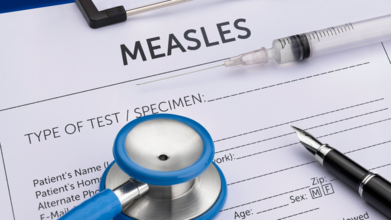- Health Conditions A-Z
- Health & Wellness
- Nutrition
- Fitness
- Health News
- Ayurveda
- Videos
- Medicine A-Z
- Parenting
- Web Stories
‘Lucky To Be Alive', US Woman Wakes Up From A Coma Just Seconds Before Doctors Begin Organ Harvesting

Credits: Canva (representational)
In a case that raises urgent ethical, medical, and systemic questions, a woman in New Mexico, US narrowly escaped having her organs harvested while she was still ALIVE. Her case exposes disturbing gaps in the US organ donation system and has sparked a nationwide debate about the protocols followed when a patient is declared beyond recovery.
Danella Gallegos, 38, was homeless when she suffered a still-unnamed medical crisis in 2022. She fell into a coma and was admitted to Presbyterian Hospital in Albuquerque, New Mexico. There, doctors told her family that her condition was irreversible and that she would never regain consciousness.
With no apparent hope left, the family made the heartbreaking decision to donate her organs to help others in need. In stepped New Mexico Donor Services, the organ procurement organization (OPO) designated to coordinate the logistics of organ harvesting but in the days leading up to the planned surgery, something didn’t feel right to Gallegos’ family.
According to her family, Danella showed subtle but unmistakable signs of life. Her sisters said they noticed tears running down her cheeks — a deeply human response. When they brought this to the donation coordinator's attention, they were told it was nothing more than a reflex.
On the day of the scheduled operation, one of her sisters claimed she felt Danella move when she held her hand. That alone should have raised immediate red flags. But the real shock came when medical staff observed Gallegos blinking in response to verbal commands — an act that clearly suggested consciousness and awareness.
Despite these signs, the organ donation coordinator present in the operating room allegedly encouraged doctors to go forward with the procedure, recommending they administer morphine and complete the surgery.
Against pressure from the donation organization, the physicians canceled the operation. That move saved Danella Gallegos’ life. In time, she emerged from her coma and ultimately made a full recovery.
Speaking after the ordeal, Gallegos admitted she felt fear while in the coma but has only patchy memories of the experience. “I feel so fortunate,” she said. “But it’s also crazy to think how close things came to ending differently.”
In response to growing scrutiny, New Mexico Donor Services denied any wrongdoing. The organization claimed it does not interfere in clinical decision-making and emphasized that only hospitals are responsible for patient care.
Presbyterian Hospital, however, painted a different picture. They asserted that New Mexico Donor Services oversees “all aspects” of the donation process. The hospital has since launched an investigation into Gallegos’s case.
Neva Williams, a veteran intensive care nurse at the hospital, offered a chilling summary to The New York Times: “All they care about is getting organs. They’re so aggressive. It’s sickening.”
This back-and-forth has laid bare the uncomfortable tension between medical ethics and the demand for transplantable organs. Here’s where it gets complicated, more than 103,000 people in the U.S. are currently on organ transplant waiting lists. Every day, approximately 13 people die waiting.
Organ procurement organizations exist to speed up the donation process and match recipients with available organs. Each donor can potentially save up to eight lives and improve 75 more through tissue and corneal donations.
Because viable organs have a very short shelf life after death, timing is everything. That urgency can create pressure — sometimes overwhelming — on hospitals and families.
The most ethically thorny donations happen under the classification of donation after circulatory death (DCD). Unlike brain death, where all brain activity has irreversibly ceased, patients in a DCD state may still have limited brain function and are typically removed from life support before organ removal begins. Doctors must wait until the heart has stopped beating for at least five minutes before they can begin the transplant process — otherwise, the organ is no longer viable.
In 2024, these DCD cases made up about one-third of all organ donations, according to government data.
What Are The Organ Donation Ethics Globally?
The United Kingdom uses an opt-out system for organ donation — meaning adults are presumed to be donors unless they explicitly say otherwise. Still, the legal framework places strong emphasis on confirming death through strict medical criteria before any organs are taken. Two main types of death are recognized:
- Circulatory death, where the heart stops beating for five continuous minutes.
- Brain stem death, which ensures the individual will never regain consciousness or breathe independently.
Importantly, in the UK, donation coordinators are strictly barred from intervening in any decisions related to life support withdrawal or patient care.
Danella Gallegos’ case has reignited an uncomfortable but necessary conversation: How much pressure is too much? When is a patient truly beyond recovery and who gets to decide? It also casts a spotlight on the increasing corporatization of organ donation, where nonprofits are under growing pressure to deliver results — often quantified in organ procurement rates — not human stories.
As the U.S. continues to rely heavily on OPOs to bridge the gap between donors and recipients, oversight and ethical accountability remain patchy at best.
While most organ donation cases proceed ethically and save countless lives, the outliers like Gallegos remind us that getting it wrong isn’t just a procedural misstep. It’s a near-death experience. For now, Gallegos is alive and healing but her experience stands as a stark reminder of what’s at stake when assumptions are made about comatose patients and when time-sensitive procedures begin to edge into dangerous ethical territory.
As hospitals and OPOs continue to work in high-pressure environments, there’s a pressing need for standardized safeguards, better oversight, and a renewed focus on what should always be the top priority, the living patient’s right to be heard, even in silence.
Measles Alert Issued in Queensland After A Bali-Returned Traveller Brought A Confirmed Case Back Home

Credits: Canva
A recently returned traveller from Bali brought a case back home in Queensland of measles. This has prompted a health warning for Brisbane and the Sunshine Coast. In fact, last week, on Thursday afternoon, the Queensland Health also issued an alert of the need and benefit of vaccinations.
So far, this year, 21 measles cases have been reported across Australia, the highest number since 2019, when there were 284 cases, reports ABC News.
Brisbane Businesses Affected
The individual who has been identified as the source of the outbreak visited several businesses in Brisbane on September 19, including:
- Uroko Sushi at Everton Park Plaza
- Miss Sophia's Gelateria on Stafford Road
- The domestic arrivals area at Brisbane Airport
- Woolworths Skygate at Brisbane Airport
On September 20, the person continued to move around the city while unknowingly infectious, stopping at:
- Yiayia's Pantry in Toowong
- Woolworths West Village
- Harris Farm Markets in West End
- Sunshine Coast Exposure Sites
On September 21, the individual travelled to the Sunshine Coast and visited several popular venues, including:
- Outside Mooloolaba Fish Market
- Outside Artigiano Gelato
- Surf Dive and Ski
- La Casa Restaurant on the Mooloolaba Esplanade
Queensland Health has released a full list of exposure sites and times on the Metro North Health website, urging anyone who visited these venues during the relevant periods to be on high alert.
Symptoms and What to Watch For
Physician Dr. Doug Shaw, a reported by ABC News, advised that anyone who may have been at these locations should carefully monitor their health. Symptoms of measles usually appear between seven and 18 days after exposure.
Early warning signs include:
- Fever
- Fatigue and tiredness
- Cough and runny nose
- Red, inflamed eyes
As the infection progresses, a blotchy red rash typically develops, starting on the face before spreading across the body.
Dr. Shaw stressed that anyone who suspects they have measles should call ahead before visiting a GP or medical centre to prevent further spread of the highly contagious virus.
Rising Measles Cases in Queensland
This latest case is the 21st measles notification in Queensland this year, with infections recently reported in Cairns, the Gold Coast, Townsville, and Middlemount near Mackay.
Nationally, Australia has recorded 121 measles cases so far in 2025, the highest figure since 2019, when 284 cases were reported. Health officials are now closely monitoring whether the country is at risk of measles once again becoming endemic.
Vaccination Remains the Best Defence
- Queensland Health reiterated that the measles vaccine is safe, effective, and free. Two doses provide long-lasting protection against the virus.
- Children are eligible for their first dose at 12 months of age and a second at 18 months.
- The vaccine is also recommended earlier for children travelling overseas, where exposure risk is higher.
- Anyone in Queensland born since 1966 who has not already had two doses is eligible for a free vaccination.
Public Health Reminder
Health authorities are urging residents to check their vaccination status and not to delay getting immunized if they are unsure. The rise in cases across Queensland highlights how quickly measles can spread in communities where immunity gaps exist.
Authorities said timely vaccination, awareness of exposure sites, and quick medical response remain the strongest tools in preventing further outbreaks.
Missing First Breast Cancer Screening Linked to 40% Higher Death Risk, Study Finds

Credits: Canva
Women who skip their first breast cancer screening appointment face a 40% higher risk of dying from the disease, according to new research published in the British Medical Journal.
The findings come from the Karolinska Institute in Sweden, where experts analyzed the long-term health outcomes of nearly half a million women. All participants received their first screening invitation between 1991 and 2020, with researchers tracking them for up to 25 years.
1 in 3 Women Missed Their First Appointment
The study revealed that almost a third (32%) of women did not attend their first mammogram appointment. This early absence had far-reaching consequences.
Data showed that women who missed their initial screening had 9.9 breast cancer deaths per 1,000 over 25 years, compared with seven deaths per 1,000 among those who attended. Importantly, the overall rate of breast cancer diagnosis was similar across both groups, suggesting that the increased mortality was due to delayed detection rather than more frequent disease.
Researchers concluded that early non-attendance not only raised the risk of late-stage diagnosis but also set a pattern, these women were less likely to attend subsequent screenings, further compounding the risk.
Why the First Screening Matters
The team behind the study emphasized that missing the very first appointment has long-lasting implications. “First screening non-participants had a 40% higher breast cancer mortality risk than participants, persisting over 25 years,” the researchers noted.
They suggested that early screening behaviour could serve as a predictive marker for identifying populations at higher risk of late-stage disease. Detecting such patterns decades in advance could help public health systems intervene earlier.
An editorial published alongside the study, written by US researchers, reinforced this point. They described the first screening as “far more than a short-term health check.” Even if no issues are detected, simply attending provides valuable information, reassurance, and guidance on what symptoms to look out for—essentially a long-term investment in breast health.
Current Breast Screening Uptake
Breast screening guidelines vary worldwide. In England, women are typically invited from age 50 until 71, with the first invitation arriving by age 53.
Latest NHS data shows that as of March 2024, around 70% of eligible women were up to date with screening. This means nearly one in three were not, a figure mirroring the Swedish study’s finding.
Claire Rowney, chief executive of Breast Cancer Now, described the numbers as “worryingly high” and called for urgent action to make screening more accessible and appealing. The charity has urged governments across the UK to push for an 80% uptake target, arguing that early diagnosis saves lives.
Broader Global Cancer Trends
The Swedish research comes against the backdrop of a projected surge in global cancer cases. A separate study published in The Lancet estimated that annual cancer deaths will rise by nearly 75%, from current levels to 18.6 million by 2050.
New cases are expected to jump 61% over the next 25 years, reaching 30.5 million annually. Much of this increase is attributed to population growth and ageing. However, lifestyle factors remain significant: around 42% of cancer deaths are linked to modifiable risks such as smoking, poor diet, high blood sugar, and toxin exposure.
Advances in Cancer Research Offer Hope
Amid these sobering statistics, researchers continue to make progress on potential breakthroughs. In a separate development, scientists have identified a protein target that could help stop the spread of pancreatic cancer.
The research, published in Nature, focused on pancreatic ductal adenocarcinoma (PDAC), the most common and aggressive form of the disease. Scientists discovered that blocking a protein called SPP1 could prevent the cancer from spreading and extend survival time.
According to experts at the Institute of Cancer Research in London, the next step will be to develop drugs that can precisely target SPP1, raising hopes of more effective treatment options in the future.
21-year-old Billy Vigar Of Chichester City Dies Of Sustaining Brain Injury

Credits: AP
Chichester City forward Billy Vigar has died at the age of 21 following a severe head injury sustained during a match last Saturday. The former Arsenal youth player collapsed during an Isthmian League fixture against Wingate & Finchley, which was abandoned after just 13 minutes.
In a statement, Chichester City confirmed that Vigar had been placed in an induced coma and later underwent surgery in an attempt to aid his recovery. Despite the procedure, his injuries proved fatal, and he passed away on Thursday morning.
The seventh-tier club added that the outpouring of support after the initial update highlighted the deep affection and respect Vigar commanded within the football community. “His family are devastated that this has happened while he was playing the sport he loved,” the club said.
While the kind of head injuries Vigar had suffered is not revealed, as per the American Association of Neurological Surgeons, there are an estimated 1.7 to 3.8 million traumatic brain injuries in the US alone, with 21% from sports-related head injuries.
Head Injuries In Soccer
As per a 2022 study published in the journal of Family Medicine and Primary Care, 22% of all the injuries in sports are head injuries, especially in football (soccer). The study notes that on an average, a football player performers 800 headers across a single season, this could also be the reason that could cause a head injuries.
A 2020 study by Auer et al. found that 22% of all football injuries are concussions. Another study by the researchers at the University of North Carolina and Emerson Hospital in Concord, MA, found that young football players are suffering serious head injuries more than before. Neurological injuries have resulted in past few decades. In fact, serious brain injuries rose in 2011, with other injuries as spinal cord injuries with incomplete recovery.
Another study by the University of Glasgow revealed that former footballers are three and half times more likely to suffer from dementia, have a fivefold increased chance of Alzheimer's, fourfold increase chance of neurone disease, and twofold increase in Parkinson's. In fact studies done by the Scotland University for Sporting Excellence and University of British Columbia also noted difference in the way brain works after heading a football.
Type Of Head Injuries Common In Football
Traumatic Brain Injury (TBI)
A traumatic brain injury occurs when a blow, jolt, or penetrating wound disrupts normal brain function. Severity can range from mild, causing brief changes in consciousness, to severe, leading to coma or death. Symptoms may include persistent headaches, difficulty with balance, sensory changes, memory problems, confusion, and speech disturbances.
Concussions
A concussion is a subset of TBI often seen in sports. It results from sudden brain “shaking” due to direct or indirect impact. Concussions typically cause short-lived neurological symptoms such as dizziness, confusion, or loss of consciousness, though symptoms can also appear hours later. While most resolve spontaneously, repeated concussions increase the risk of long-term complications. Tools like the Standardized Assessment of Concussion (SAC) and computer-based testing (ImPACT) are sometimes used to guide return-to-play decisions, though they are not fully reliable.
Second Impact Syndrome (SIS)
SIS is a rare but often fatal condition that occurs when a second concussion strikes before full recovery from the first. The brain swells rapidly, leading to a dangerous rise in intracranial pressure. High-risk sports include boxing, football, hockey, soccer, and skiing.
Coma
A coma is a deep state of unconsciousness in which a person is alive but unresponsive. Recovery can vary widely, depending on the injury. The Glasgow Coma Scale is commonly used to measure severity, while CT or MRI scans help identify structural brain damage.
Chronic Traumatic Encephalopathy (CTE)
CTE is a degenerative disease linked to repeated head injuries, often in athletes. Symptoms in developing years later include memory loss, depression, impaired judgment, and, in advanced stages, dementia and movement disorders. A 2017 study found CTE in 87% of examined former football players’ brains, highlighting the long-term risks of repeated trauma.
© 2024 Bennett, Coleman & Company Limited

